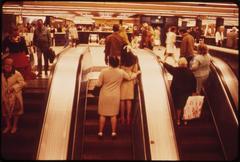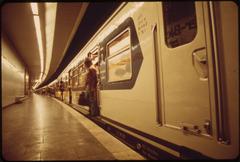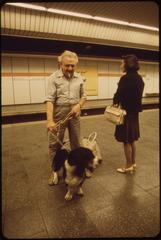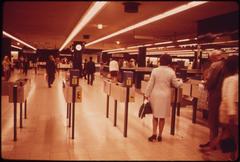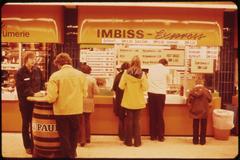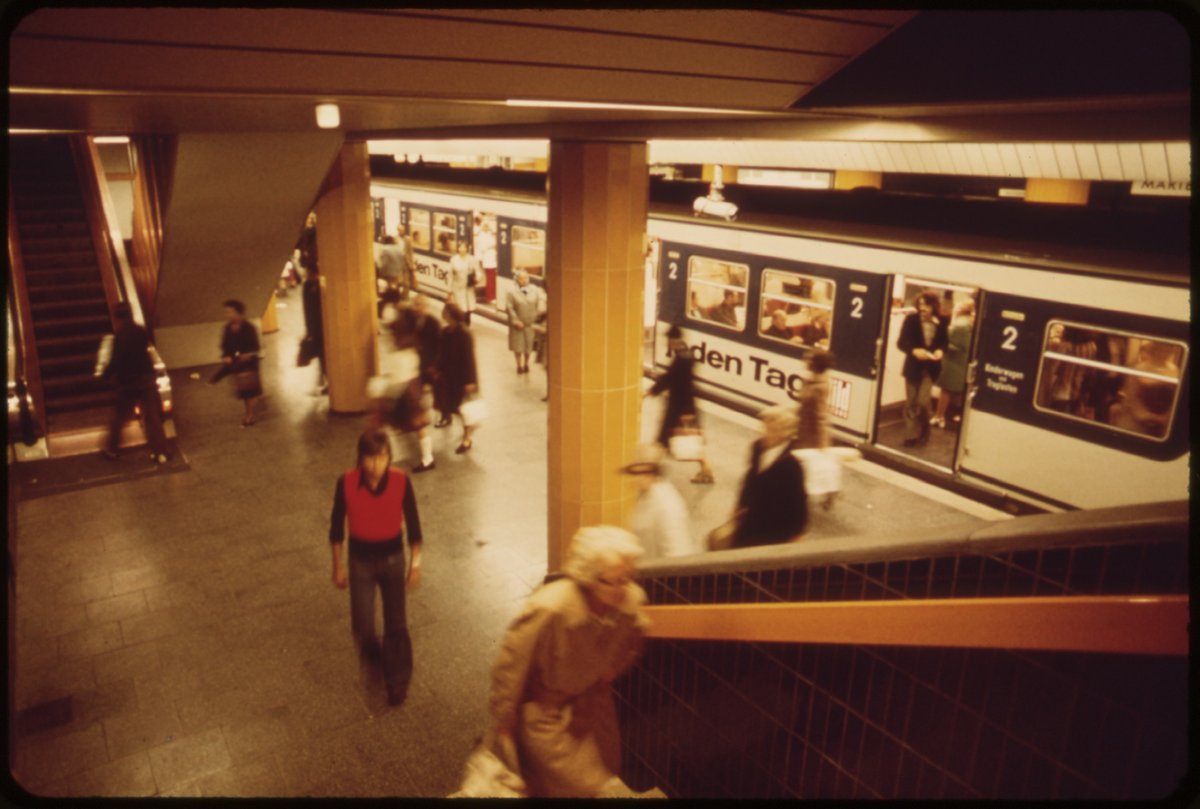
München Marienplatz Station: Visiting Hours, Tickets, and Travel Guide
Date: 14/06/2025
Introduction
Marienplatz, the historic and cultural heart of Munich, Germany, has captivated visitors for centuries. Established in 1158 by Duke Henry the Lion, this iconic square has evolved from a bustling medieval marketplace into the city’s vibrant urban hub. Today, Marienplatz not only showcases Munich’s rich architectural heritage and lively city life but also sits above the deep and busy München Marienplatz Station—one of the nation’s most important transit interchanges, connecting both the S-Bahn and U-Bahn networks and serving over 175,000 passengers daily (schnoes-bau.de; muenchen.de; en.wikipedia.org).
Marienplatz’s heritage is reflected in landmarks like the Mariensäule (Marian Column), erected in 1638 as a symbol of resilience, and the neo-Gothic Neues Rathaus (New Town Hall), renowned for its daily Glockenspiel performances (munich.travel; muenchen.de). With a wealth of museums, markets, and cultural attractions within walking distance, Marienplatz is a true gateway to Munich’s vibrant city experience.
This guide provides everything you need to plan your visit: from Marienplatz visiting hours, ticketing, and accessibility, to practical tips, architectural insights, and travel advice. It also covers nearby attractions such as the Frauenkirche, Viktualienmarkt, and Munich Residenz, equipping you with all the essentials for a memorable trip (livingnomads.com; munichmanual.com).
Contents
- Early Development of Marienplatz
- Transformation into a Transportation Hub
- Architectural and Engineering Features
- Practical Visitor Information (Visiting Hours, Tickets, Accessibility, Tours)
- Marienplatz Station’s Urban Role
- Renovations and Modernization
- Marienplatz in Munich’s Historical Narrative
- Key Historical Milestones
- FAQs
- Architectural Landmarks and Surrounding Sites
- Markets, Shopping, and Culinary Experiences
- Cultural Attractions and Museums
- Parks and Outdoor Experiences
- Practical Visitor Information: Visiting Hours, Tickets, and Tours
- Notable Nearby Attractions
- Local Experiences and Hidden Gems
- Visual and Interactive Resources
- Conclusion & Call to Action
Early Development of Marienplatz
Established as “Marktplatz” in 1158, Marienplatz quickly became Munich’s main marketplace and a focal point for city life, hosting tournaments, festivals, and civic events (schnoes-bau.de; explorial.com). The square was renamed in the 19th century to honor the Virgin Mary, symbolizing the citizens’ devotion during crises such as the cholera epidemic. The Mariensäule (1638) stands as a tribute to the city’s endurance, commemorating the end of Swedish occupation during the Thirty Years’ War (travelsetu.com).
Transformation into a Transportation Hub
Munich’s growth demanded improved public transit, leading to the development of the S-Bahn and U-Bahn networks. The 1972 Summer Olympics expedited the construction of Marienplatz Station (1966–1971), which now connects seven S-Bahn lines (S1–S6, S8) and two U-Bahn lines (U3, U6), making it Munich’s busiest interchange (en.wikipedia.org; mvv-muenchen.de; u-bahn-muenchen.de).
Architectural and Engineering Features
Designed by Alexander von Branca, Marienplatz Station features a distinctive color scheme—orange, dark blue, and dark green—to aid wayfinding. Its innovative platform layouts manage high passenger volumes, while the spacious concourse offers shops and services, blending transit efficiency with urban convenience (mvv-muenchen.de; u-bahn-muenchen.de).
Practical Visitor Information
Marienplatz Visiting Hours and Tickets
- Square: Open 24/7.
- Neues Rathaus Tower: Daily, 9 a.m.–7 p.m. (last elevator at 6:30 p.m.).
- Glockenspiel: 11 a.m. & 12 p.m. daily; 5 p.m. (March–October) (muenchen.de).
- Tickets: Marienplatz access is free. Tickets required for Neues Rathaus tower, guided tours, and nearby attractions. Public transport tickets available via station machines or the MVV app (mvv-muenchen.de).
Accessibility
Marienplatz Station is fully accessible, with elevators, escalators, and step-free pathways, meeting modern standards (mvv-muenchen.de).
Guided Tours and Photographic Spots
Numerous guided walking tours originate at Marienplatz, providing rich historical context. The Marian column, Neues Rathaus, and Glockenspiel are top photo spots, especially during performances or at sunset (explorial.com).
Marienplatz Station in Munich’s Urban Life
Since its opening in 1971, Marienplatz Station has been the nerve center of Munich’s public transit, conveniently linking visitors to major city landmarks such as the Frauenkirche and Viktualienmarkt (u-bahn-muenchen.de).
Renovations and Modernization
Major upgrades between 2003 and 2006 enhanced platform width, passenger flow, and accessibility, making the station future-ready and paving the way for the new 2. Stammstrecke S-Bahn tunnel (mvv-muenchen.de).
Marienplatz in Munich’s Historical Narrative
Marienplatz embodies the city’s evolution, from medieval origins and the construction of the Neues Rathaus (1867–1909) to its modern identity as a transportation and cultural hub (architectureofcities.com; munich.travel).
Key Historical Milestones
- 1158: Munich founded; marketplace established (schnoes-bau.de).
- 1638: Mariensäule erected (explorial.com).
- 1867–1909: Neues Rathaus constructed (architectureofcities.com).
- 1966–1971: Marienplatz Station built (en.wikipedia.org).
- 2003–2006: Major station renovations (mvv-muenchen.de).
Frequently Asked Questions (FAQ)
Q: What are the Marienplatz visiting hours?
A: The square is always open. Shops and attractions have varying hours; the Glockenspiel performs at 11 a.m. and 12 p.m. daily.
Q: Where can I buy public transport tickets?
A: At Marienplatz Station (machines or MVV app).
Q: Is Marienplatz Station wheelchair accessible?
A: Yes, with elevators and step-free access.
Q: Are guided tours available?
A: Yes, several start from Marienplatz.
Q: What are the best photo spots?
A: The Marian column, Neues Rathaus, and Glockenspiel.
Marienplatz Station: Depth, Structure, and Connectivity
Marienplatz Station is a major interchange beneath the square, linking S-Bahn and U-Bahn networks. The S-Bahn platforms are about 36 meters below street level, making this one of Germany’s deepest stations; U-Bahn platforms are at 24 meters (Deutsche Bahn). A new tunnel at 27 meters depth will soon connect with the future Marienhof S-Bahn station.
- S-Bahn: Two island platforms (S1–S8)
- U-Bahn: Two side platforms (U3, U6)
Entrances and exits are integrated into Marienplatz and nearby streets, ensuring easy access to shopping, the pedestrian zone, and historic sites (Munich Info). The station is fully accessible, with tactile guidance and audible announcements (Munich Tourist Board).
Facilities and Services
- Tickets: Multilingual machines and staffed counters (Munich Tourism)
- Shops: Bookstores, fashion, convenience stores (Munich Info)
- Dining: Cafés and bakeries within and around the station
- Restrooms & Seating: Accessible and clean, ample seating
- Safety: CCTV, emergency systems, and security
Intermodal Connections
- S-Bahn: Direct to Munich Airport and Hauptbahnhof
- U-Bahn: U3, U6 to Olympic Park, university district
- Bus 52: To Munich Zoo (Munich Info)
- Taxis/Rickshaws: Near main exits
Visiting Marienplatz: Hours, Tickets, and Attractions
- Square: Open 24/7
- Neues Rathaus Glockenspiel: Shows at 11 a.m. and 12 p.m., 5 p.m. (March–October)
- Tickets: Free entry to the square; tickets for tower access, tours, and museums
- Nearby: Viktualienmarkt, Frauenkirche, Munich Residenz within walking distance
Wayfinding and Accessibility
Bilingual signage, color-coded transit lines, floor markings, and large maps ensure easy navigation (European Rail Guide). Elevators, tactile paving, and audible announcements ensure barrier-free access.
Construction Updates and Safety
The 2. Stammstrecke project may cause temporary reroutes or closures; safety is maintained through monitoring and active protocols (Deutsche Bahn).
Practical Visitor Tips
- Peak hours: Avoid mornings (7–9 a.m.) and evenings (4:30–6:30 p.m.) for a more relaxed visit (Travel With Kinsley).
- Payment: Credit cards widely accepted; cash handy for small purchases.
- Safety: Marienplatz is generally safe; be vigilant in crowds.
Architectural Landmarks and Historic Sites
Neues Rathaus (New Town Hall) & Glockenspiel
A neo-Gothic landmark with a famous Glockenspiel show (11:00 a.m., 12:00 p.m., and 5:00 p.m. in summer), and an observation tower with city views (source).
Altes Rathaus (Old Town Hall)
Gothic structure with a Toy Museum, open Tuesday–Sunday, 10 a.m.–5 p.m. (source).
Mariensäule (Mary’s Column)
A 1638 monument symbolizing Munich’s survival and faith (traveltriangle.com).
Frauenkirche
Munich’s cathedral, famous for its twin domes and panoramic tower views (source).
St. Peter’s Church (Alter Peter)
The city’s oldest parish church with a viewing tower (9:00 a.m.–8:00 p.m. April–September; until 6:00 p.m. October–March) (thetouristchecklist.com).
Markets, Shopping, and Culinary Experiences
Viktualienmarkt
Munich’s open-air food market, open Monday–Saturday, 8:00 a.m.–8:00 p.m. (source).
Maximilianstraße & Shopping Streets
Luxury shopping and bustling pedestrian zones (source).
Cafés, Beer Halls & Dining
From terrace cafés to the legendary Hofbräuhaus (muenchen.de).
Cultural Attractions and Museums
- Munich Residenz: Royal palace with museums and theatre (source)
- Kunstareal (Art Quarter): World-class art museums
- Deutsches Museum: Science and technology exhibitions
Parks and Outdoor Experiences
- English Garden: One of the world’s largest urban parks (source)
- Seasonal Events: Christmas market, FC Bayern celebrations, concerts
Notable Nearby Attractions
- Nymphenburg Palace: Baroque palace complex (source)
- Olympiapark: Olympic site with tours and panoramic tower
- BMW Welt: Automotive museum and showcase
Local Experiences and Hidden Gems
- Street performers & markets: Lively street culture
- Toy Museum: Delight for families and collectors
- Café culture: Enjoy a coffee at a terrace café
Visual and Interactive Resources
For maps and virtual tours, see Munich’s official tourist map. High-resolution images and interactive tools are available on official sites.
Summary & Call to Action
Marienplatz is a living testament to Munich’s blend of history, culture, and urban life. Its transformation from a 12th-century marketplace to a pedestrian-friendly square and a crucial transit station reflects the city’s spirit (schnoes-bau.de; en.wikipedia.org). The station’s design and ongoing modernization ensure accessibility and efficiency for millions of visitors (mvv-muenchen.de).
With world-class landmarks, vibrant markets, and seamless transit connections, Marienplatz is the perfect starting point for discovering Munich (munich.travel; muenchen.de). For real-time updates and guided tours, download the Audiala app.
Alt tags include keywords such as ‘Marienplatz visiting hours,’ ‘Marienplatz tickets,’ and ‘Munich historical sites’ for SEO.
References and Further Reading
- Marienplatz Station: A Complete Visitor’s Guide to Munich’s Historic Heart and Transit Hub, 2025, Schnoes-Bau
- Marienplatz Munich: Visiting Hours, Tickets, and Historical Sites Guide, 2025, Munich Travel
- Marienplatz Station and Visiting Munich’s Historic Heart: A Comprehensive Guide, 2025, Deutsche Bahn
- Marienplatz Visiting Hours, Tickets, and Top Attractions in Munich, 2025, Munich Travel
- Marienplatz Munich Travel Guide, 2025, Living Nomads
- Ultimate Guide to Navigating Munich’s Public Transportation System, 2025, Munich Manual
- Everything You Need to Know About Public Transportation in Munich, 2025, Earths Attractions
- Marienplatz Munich Tourist Information, 2025, Munich Info
- Marienplatz and Munich’s Architectural Milestones, 2025, Munich Travel
- Introducing Munich: Marienplatz, 2025, Introducing Munich
- Architecture of Cities: Munich, 2025

